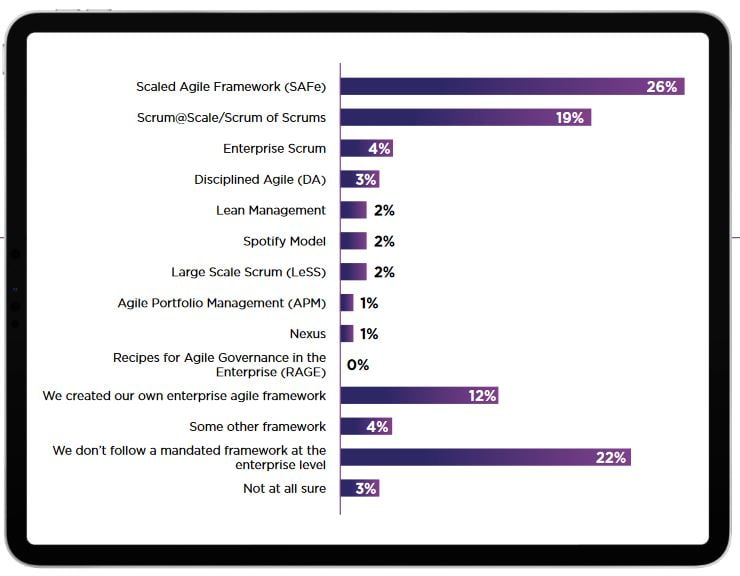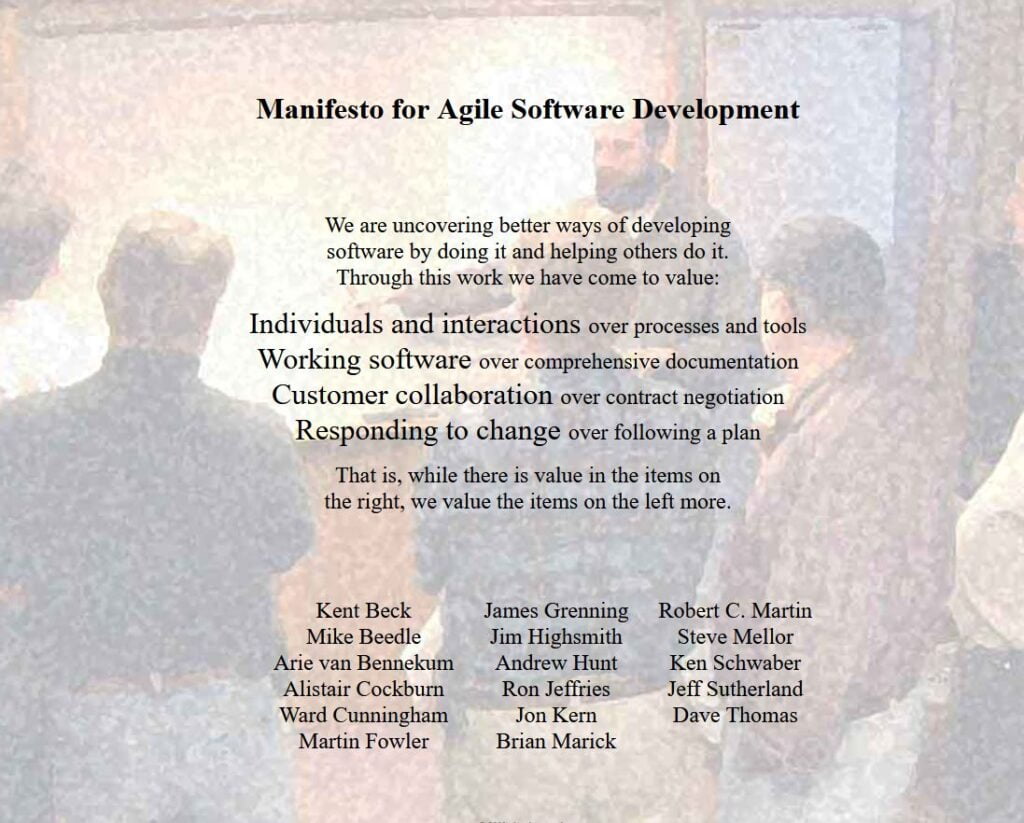
While agile saw its humble beginnings in the dawn of technology as we know it today, it has evolved to take over the world of business by storm and is present even in health care, government, and aerospace industries. Anywhere where there is need for graceful adaptation, speed of delivery, and customer satisfaction, there is the need for agility.
In today’s dynamic landscape, the demand for agility has transcended being merely a desirable trait; it has evolved into a non-negotiable set of skills essential for numerous roles across organizations. It’s a skill for the organization and for its employees, regardless of the name of their role.
While the concept of agile may seem straightforward, the journey to understanding its depth and nuances can be far more engaging. To unravel the essence, I invite you on a journey to deconstruct and build back the significance of agile.
You can watch a shorter video version here
I see you’re a reader! Let’s continue with this article.
Let’s begin with what agile is NOT.
What Agile is Not
1 – “Kumbaya”, “Tree Hugging”, Over-collaboration, and Doing Everything Together
Agile is often misunderstood as a utopian vision of constant collaboration, where everyone sits in a circle singing “Kumbaya.”

However, it’s crucial to dispel the myth that agile means overdoing collaboration or making every decision a group endeavor. While collaboration is a core principle, agile emphasizes efficient collaboration and flexible teamwork, not a blanket insistence on doing everything together. The goal is to strike the right balance between individual contributions and collaborative efforts, ensuring optimal productivity and innovation.
2 – Agile is Not Change Everything All the Time, But Change Anything Anytime
Agile doesn’t advocate for chaos or constant disruption. Often associated with the world of startup and innovation, it can function in any environment. And in many organizations, dealing with change requires a more disciplined approach than burning things down to the ground.
While responding to change is one of the core values of agile, it’s not about letting everyone change everything whenever they please. Rather, it promotes the flexibility to change aspects deemed necessary at any point in the process.
Can you spot the difference? In agile approaches, it’s about embracing change in response to feedback and evolving requirements, not creating an environment where everything is in a perpetual state of flux. Agile provides a structured ground for adaptability, allowing changes with a purpose rather than for the sake of change itself.
3 – Agile is Not the Frameworks Themselves
Agile is not confined to specific frameworks like Scrum or SAFe. Which from 2017 to 2023 seemed to be all organizations envisioned for agility, at least if you look at the latest State of Agile Report.

Despite a huge adoption of Scrum and it’s scaled approaches, this million dollar industry of agile transformations still fails to see results proportional to the investments.
The danger lies in becoming myopic and adhering to a single framework without considering the broader agile principles. And most importantly: your organization needs. The battle between Kanban and Scrum, for example, misses the point of agile’s flexibility. Agile is about adapting methodologies and practices to fit the context, not adhering rigidly to a particular framework. The focus should be on understanding the principles behind the frameworks and tailoring them to suit the unique needs of each department, team, and sometimes even the project.
4 – Agile is Not “No Plans” or “Plans Are Useless”
More and more I hear even smart people having allergic reaction to plans. Plans are not bad and will always be needed in the context of organizations. Heck, even as you decide which path to take to go to the grocery there’s a plan. And when you need to change route due to construction or a literal roadblock, that’s your adaptation to the plan, generating a new plan.
Simple, isn’t it? I know I oversimplified it a bit.
Contrary to the misconception that agile implies a lack of planning, it doesn’t negate the importance of strategic thinking. Agile recognizes that detailed plans may become obsolete in rapidly changing environments, but it doesn’t advocate for a complete absence of planning. Instead, it encourages iterative planning and adapting plans as new information emerges. Plans are not discarded; they are adjusted in response to evolving circumstances, ensuring that the team remains aligned with project goals.
And yes, sometimes, like we saw in the pandemic years, plans do get entirely thrown out. And a new one still is crafted.
5 – The Myth of “Everything is Complex”
The notion that everything is so complex that preparation is futile is a gross misinterpretation of agile principles and a lack of understanding how real life, especially in organizations and in the technology space works.
First, not everything is complex. Not everything needs “discovering as we go”. It’s a dangerous assumption to operate a business based on the flavor of the day. Second, even complexity can be dealt with better by using simplification and preparation. Even people in the army or artists plan and prepare, despite knowing that on D-day things will go as they can.
Agile doesn’t dismiss the importance of preparation; it acknowledges the inherent difficulty in projects and encourages a mindset of continuous adaptation. While it’s impossible to predict every detail, you do prepare as much as possible while being ready to adjust.
It’s about proactive preparation coupled with the flexibility to respond effectively to unforeseen challenges.
6 – Agile Is NOT Whatever You Want It to Be
Agile is not a free pass for self-defined practices without adherence to core principles or solid background. It’s also not a one-size-fits-all concept where teams can define their agile in a vacuum. It provides a set of guiding principles, and while it allows for flexibility in implementation, it requires a sincere commitment to its core values. Using the term “agile” as a carte blanche for any practice or technique however random risks diluting its true essence and effectiveness.
Example of this in practice? When you have a team that never misses a deadline and yet reaches burnout quite often, no agility is in place. No respect for the human side exists when there is no sustainable pace. It’s impossible to adapt rapidly to new circumstances when you don’t even know if your team will be functional the next day.
7 – Agile Is Not Having to Fail to Learn
The concept of “fail fast” is often misinterpreted as intentionally inducing failure. However, agile does not advocate for failure as a prerequisite for learning. Instead, it encourages a culture of rapid learning, which includes learning from both successes and failures. The emphasis is on quick feedback loops, allowing teams to learn from experiences, iterate, and continuously improve. Learning from personal successes and the successes of others is equally integral to the agile mindset, promoting a holistic approach to improvement.
Now that we got some important misconceptions out of the way, let’s have a brief look into how agile started.
The Origins of Agile
It All Started with the Manifesto, But It Did Not End There

The Agile movement was ignited with the Agile Manifesto in 2001. Almost all of the signatories were experience software developers, or people who understood in a deeper level how technology works. It’s important to note that they codified agile principles, but they didn’t invent agility as a mindset so to speak.
What I mean by that is that in the late 1990’s there was a global quest for better ways of developing great software. Even I, working in Brazil as a young software developer, was exposed to that style of thinking and working, and luckily got initiated into software via agile.
The manifesto did lay the groundwork for various agile methodologies, with Extreme Programming (XP) and Scrum emerging as early front-runners. As the demand for agility expanded beyond small teams, scaled frameworks like SAFe gained prominence. Although you can have simple and more adaptive large-scale frameworks such as Nexus ad LeSS.
It is evolving: “We Are Uncovering” Not “We Have Discovered”
A fundamental tenet of Agile lies in the acknowledgment that we are continuously uncovering better ways of working. This emphasis on continuous improvement propels the community to challenge existing norms and explore innovative methodologies. The keyword here is “uncovering,” underscoring the dynamic nature of Agile. Practitioners don’t get crystallized in frameworks; instead, they engage in a perpetual journey of exploration, staying open to evolving practices and refining their approaches based on ongoing discoveries.
Why Agile Then? Addressing Technology, Business, and Schedule Together
Agile’s inception was a response to several pressing issues. On the technology front, challenges in maintaining quality while ensuring speed became increasingly apparent. Businesses grappled with questions related to defining what needed to be built, for whom, and why. Additionally, traditional project management struggled with rigid timelines, prompting a need for more flexible approaches.
Agile addressed these issues by providing a foundation that not only tackled technical and business complexities but also introduced adaptive planning, ensuring projects could align with ever-changing timelines, a critical need in the fast-paced world of technology and business.
And so it began… in software. And today it’s everywhere.
Agile at its Core
I bet you are thinking, that’s all very nice, but what about agile today?
Well, do you recognize this scenario?
A Typical Scenario
The project is late. While everybody seems to know what to do, new requests for yet another little feature keep coming. While managers and analysts keep signing off on documents, the truth is that the website _a simple website!!_ is not ready yet.
The few webpages that were approved and released, can’t yet be deployed into production because that team’s schedule doesn’t allow for it. The development team feels deflated, and some people are actively disengaged. Especially those who work on that project only 30% of their time, as they feel this is not their problem as they check the math.
And now, to make things move faster, some project managers are adding two more “resources” into the production support team during this release cycle. Eventually the website was released, 6 months later, and with way too many defects to fix.
This used to happen in the early 1990s. This happens today, decades later.
So how to answer the question of what is agile?
Agile solves real world problems, even though we sometimes make references to an “agile mindset”.
Agile is an approach where projects or outcomes are subdivided into iterations. The output of iterations is measured continuously and used as input to evaluate the schedule. Features (or whatever you name them) are implemented in order of business value, so that the most valuable thing is implemented first. The schedule is primarily managed by manipulating scope, aka, keeping the scope elastic. Quality is kept as high as possible. Yep, never forget quality if you want to be able to be agile, adaptive.
In a future post I will explore the elements of quality and scope elasticity, as they are so ignored in the current state of agile.
A quote from Uncle Bob that I love is that Agile is the end of hope in project management.

Management by hope! Have you experienced it before? I will paraphrase Uncle Bob insight for you on the matter.
When you hope for things to go well you stop any intelligent control in your project.
Always be managing your project. Never “hope” things are going well enough. Never “hope” for improvement. Look at the data, which should be produced as your iterations, or learning cycles end. Use that data to intervene in an informed way. Kill all hope. Use your data.
So, hope or agile? My bet is that agile is better.
What problem does agile solve (today)?
Agile of today has transcended its origins in software development to become a transformative mindset addressing contemporary challenges in organizations across various industries.
Pick a company of any size and any cultural makeup. Chances are it still faces perpetual delays, wildly inconsistent results, and a growing need for speed in delivering solutions. As this demand for faster project delivery intensifies, Agile emerges as a holistic solution where you also don’t abandon themes such as quality and human insight.
Agile is not only aimed to rectify the chronic issue of projects running behind schedule but also sought to instill a culture of continuous improvement, enabling teams to learn from mistakes, catch issues early, and optimize both technological and organizational architectures. From fostering predictability (or reliability, as some call it) and human-centric communication to streamlining software development life cycles, Agile offers a comprehensive toolkit to address the multifaceted challenges of modern business, ensuring not just growth but sustained value delivery to customers.
What agile can do for you:
- Enhances project predictability and on-time delivery.
- Facilitates early detection and correction of mistakes.
- Fosters a customer-centric approach for sustained value delivery.
- Promotes a culture of continuous improvement and learning.
- Streamlines software development life cycles for efficiency.
- Prioritizes human-to-human communication over bureaucratic processes.
- Ensures extreme levels of quality, especially in sensitive domains.
- Optimizes organizational and technological architectures.
- Mitigates delays, losses, and risks in project management.
- Aligns work management with the overarching purpose and goals of the company.
Those are problems agile aims to solve.
What is agile and what problem does it solve?
As we reach this point, my best hope is that you are now able to answer this question confidently whenever asked.
Agile proposes that you work effectively, intelligently, and adaptively.
In other words: generate results working on the problem worth solving, deal with change early and gracefully, and actively manage the work process and the quality of what is produced.
Agile is not woo-woo talk. It’s not generic feel-good team building. It has a focus on action. On producing results and managing the processes that lead to them.
Influenced by Systems Thinking, Lean principles, and various management sciences, Agile is an approach that guides organizations in executing work efficiently and effectively. It emphasizes the importance of working on the right things, maintaining an optimal pace, and utilizing resources wisely. Rooted in principles of customer satisfaction without ignoring employee fulfillment, Agile not only addresses current needs but also future-proofs ways of working (WoW). This forward-looking approach enables organizations to navigate changes in the best way possible without incurring substantial setbacks.
Agile is a pragmatic, results-driven methodology that transcends mere buzzwords. It advocates for actionable strategies and tangible outcomes. It is, at its core, a compass for navigating change with resilience.
If you are interested in growing your agile skills, other than the blog and videos, consider joining the newsletter Agile Circle. It’s totally free, and you’ll receive insights in your inbox, be invited to events and workshops in our community of practice, The LAB of All Things Agile, and get first word in discounts for our paid programs and coaching.



